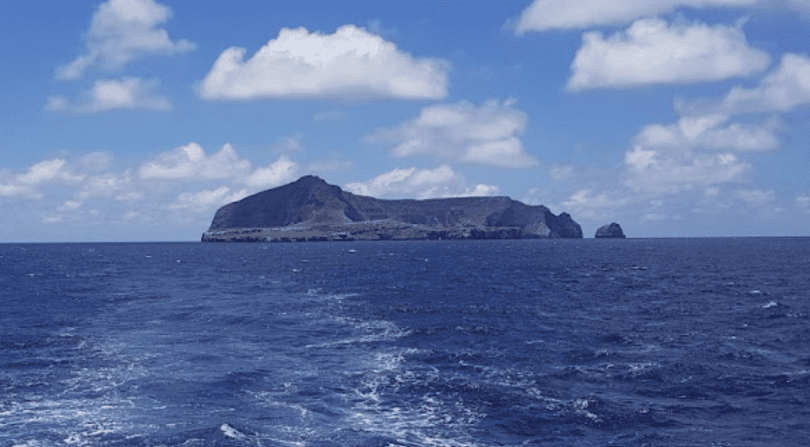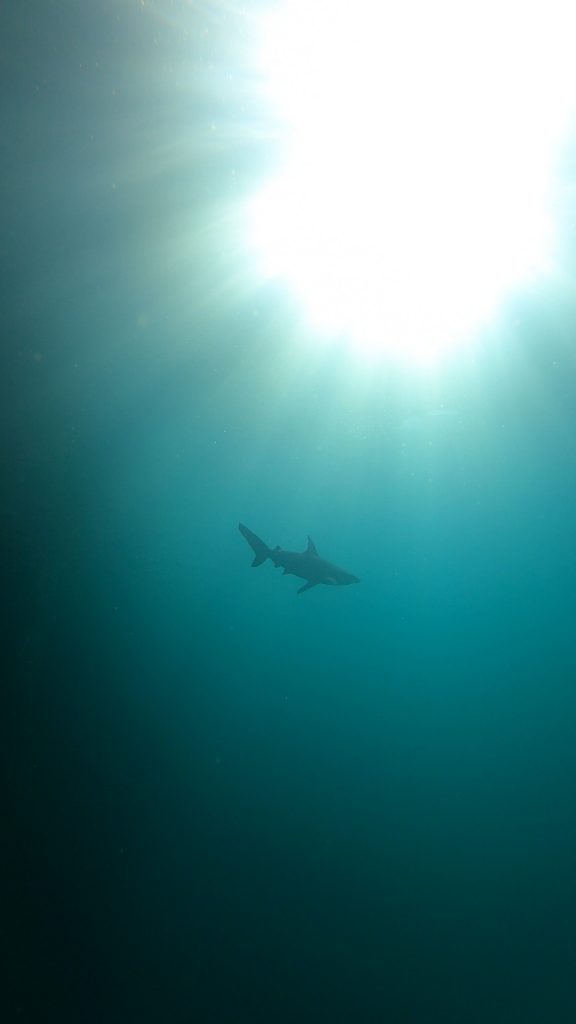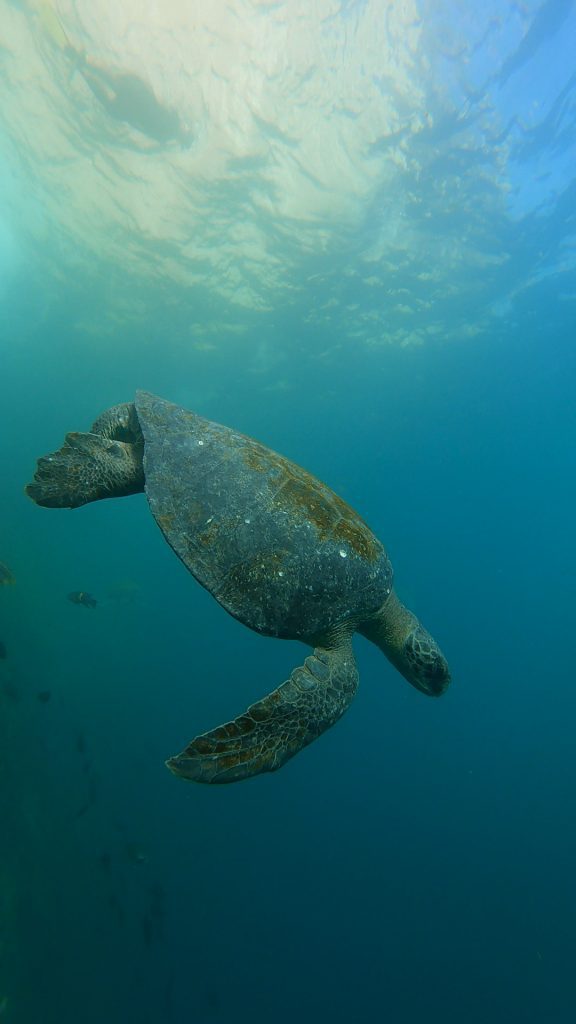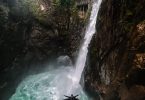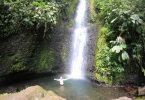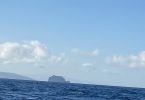Wolf Island is one of those remote, uninhabited places in the Galapagos that sounds like something out of an adventure story. It’s part of an outlying group of islands that rise from extinct volcano summits, creating these small, isolated landforms. Though we didn’t make it to Wolf Island ourselves—mainly because the diving spots here are more suited for advanced divers—we learned a lot about its reputation and unique underwater world during our time exploring the archipelago.
From what we gathered, Wolf Island is often praised as one of the top dive sites in the entire Galapagos, if not the world. It’s a bucket-list destination for those seeking thrilling, world-class diving experiences. During our trip, we heard plenty of stories from fellow travelers and guides about the breathtaking underwater scenery. Darwin and Wolf Islands, in particular, draw divers from across the globe, with promises of encounters with sharks, rays, and all sorts of incredible marine life.
While we didn’t dive here ourselves, we were fascinated by what we learned. So, for those of you up for the challenge, we’ve put together a guide filled with everything you’ll need to know about this iconic diving destination.
Where is Wolf Island Located?
Wolf Island sits way up in the northernmost reaches of the Galapagos archipelago, far from the more commonly visited islands. It’s one of those truly remote places that feels almost untouched by time, and it’s not too far from Darwin Island—another renowned spot for diving.
Though we didn’t venture that far north during our trip, we heard plenty of fascinating stories from other travelers who made the journey. There’s something special about knowing these remote islands exist, almost like they’re on the edge of the world, with the promise of epic marine adventures for those bold enough to explore.
How to Get to Wolf Island?
Darwin and Wolf Islands are by far the most challenging to reach in the Galapagos, primarily because of their remote location. Regular cruises don’t make it out that far, so if you’re dreaming of visiting these islands, the only way to do it is on a live-aboard scuba cruise. We met a few divers during our time in the Galapagos who were gearing up for one of these trips, and they were buzzing with excitement about what awaited them in those distant waters.
The live-aboard cruises offer dedicated dive itineraries for Wolf and Darwin, with specialist dive yachts making the journey out there. Each trip comes with a naturalist dive guide to help you navigate the unique conditions and marine life in these waters. However, it’s important to know that diving around these islands isn’t for beginners. The strong currents can be tricky to handle, so it’s recommended for experienced divers only.
Even though we didn’t dive at Wolf or Darwin, hearing about the intensity and beauty of the underwater life out there was thrilling in itself. These islands are on another level when it comes to world-class diving.
Wolf Island History
Wolf Island, like much of the Galapagos, has a dramatic origin story—it’s the peak of an extinct undersea volcano that once pushed up from the ocean floor. Standing there today, it’s surrounded by a variety of dive sites, including volcanic shelves, towering cliffs, and hidden underwater caves. Even though we didn’t dive at Wolf, the volcanic landscape really stuck with me—there’s just something about knowing how these formations were born that makes them feel even more awe-inspiring.
What really makes Wolf Island special is the incredible marine life that calls these waters home. Every dive site around the island offers a unique view into the underwater world, with everything from playful sea lions to massive schools of fish and, of course, the famed sharks that frequent these waters.
Interestingly, Wolf Island takes its name from Franz Theodor Wolf, a German geologist who devoted much of his life to studying the geology of the Galapagos. During our trip, we came across many places and species named after explorers, but there was something about the story of this island that really connected with me—maybe it was the sense of discovery, or maybe just knowing that there’s always more to uncover in these magical islands.
Wolf Island’s Marine Life
The waters around Wolf Island are teeming with breathtaking marine life, thanks to the cold currents that attract an abundance of fascinating species. During our time in the Galapagos, we heard countless tales from fellow divers about the sheer variety of sharks that call these waters home. From Galapagos sharks and white-tipped reef sharks to the awe-inspiring whale sharks and even the elusive hammerheads, Wolf Island seems like a dream for anyone passionate about marine life.
It’s not just the sharks, though—divers also report frequent encounters with rays, including manta rays, and sea turtles gliding through the currents. Although we didn’t get the chance to dive here, hearing these stories gave us a sense of just how wild and rich these waters are.
Unfortunately, the remoteness of Wolf Island also makes it vulnerable to illegal fishing. We learned that in response to this threat, the Galapagos National Park Authority set up a floating station here back in 2008. The station helps patrol the waters to protect the incredible marine biodiversity that makes this place so special. It’s comforting to know that there’s an effort in place to preserve this fragile ecosystem, especially after hearing about the challenges it faces from human activity.
Wolf Island Dive Sites
Though Wolf Island has no landing sites, it more than makes up for it with an incredible range of dive spots that draw thrill-seeking divers from all over the world. The lack of a place to set foot only adds to the island’s mystique, making the underwater experience feel even more special. While we didn’t dive there ourselves, just knowing how untouched and remote this island is made us imagine how magical it must be to explore its hidden depths. From the stories we heard, the dive sites around Wolf Island offer everything from volcanic formations to encounters with some of the ocean’s most majestic creatures, making it a must-visit for seasoned divers.
Shark Bay
Shark Bay is one of those places that instantly captures the imagination. It’s one of the top spots around Wolf Island to see big schools of Scalloped Hammerheads, along with Silky and Galapagos sharks. While we didn’t get the chance to dive here ourselves, we spoke with divers who had, and the way they described it made us feel like we were right there with them, surrounded by these majestic creatures.
The currents in Shark Bay can be pretty intense, though, so experienced divers recommend finding shelter among the underwater rocks. It’s the perfect way to relax and watch the drama of the deep unfold in front of you. I remember thinking how incredible it must be to sit still in that moment, as the ocean moves around you, bringing schools of hammerheads into view.
And it’s not just the sharks that make Shark Bay so special—dolphins, Galapagos sea lions, eels, rays, and Green sea turtles also frequent these waters. Not to mention the enormous schools of multicolored fish that sweep through, adding vibrant flashes of color to the already magical underwater world. It’s no wonder this spot is considered a paradise for divers.
The Pinnacle
The Pinnacle is widely regarded as one of the trickiest dive sites in the Galapagos, and from what we heard during our trip, it lives up to its reputation. The strong and unpredictable water currents here are nicknamed ‘the washing machine,’ which gives you an idea of just how intense the dive can be. It’s definitely a challenge meant for more experienced divers.
But for those brave enough to take on The Pinnacle, the reward is absolutely worth it. Divers who navigate the currents are treated to breathtaking views of underwater caves that feel like secret passageways in the ocean. It’s not just the scenery that makes this dive unforgettable, though. The marine life here is nothing short of spectacular. Marble rays are often seen gracefully gliding through the water, and several species of reef sharks can be spotted patrolling the area. We didn’t get the chance to experience The Pinnacle firsthand, but listening to other divers talk about it, I could almost imagine the rush of swimming through those powerful currents, surrounded by some of the ocean’s most magnificent creatures.
El Derrumbre
El Derrumbe, located on the southeast side of Wolf Island, is a dive spot with a name that perfectly captures its dramatic landscape. “El Derrumbe” means “landslide” in English, and it’s easy to see why—it features a steep slope covered in rocks and pebbles, creating an almost otherworldly underwater scene.
Divers who brave this spot are often rewarded with the thrill of encountering large groups of hammerhead and Galapagos sharks. The idea of swimming alongside so many sharks is both thrilling and humbling. We didn’t dive here ourselves, but hearing others describe it, I could picture how surreal it must be to witness such powerful creatures in their element. And if you’re really lucky, there’s even a chance to spot a whale shark passing by, making the experience at El Derrumbe truly unforgettable.
The Anchorage
Wolf Island’s Anchorage is a popular spot for night diving, offering a completely different underwater experience compared to daytime dives. The depths here drop to around 70 feet, and with the currents usually being mild, it’s a perfect place to explore the deep in the calm of night. One of the most thrilling parts of diving at this site is the chance to see sharks feeding at dusk—an experience that must be both eerie and awe-inspiring.
But what really stands out about Wolf Island’s Anchorage is the opportunity to spot the peculiar Red-lipped Batfish. This odd-looking fish, with its striking red lips and unique appearance, quickly became a must-see for divers. Although we didn’t dive at night during our trip, hearing about the Red-lipped Batfish made me wish we could have experienced this quirky side of the Galapagos. There’s something fascinating about coming across such an unusual creature in a place already brimming with extraordinary marine life.
North Islet
North Islet, or “The Banana” as it’s often called, is a thrilling wall dive spot with a diverse range of rock formations, including caverns, tunnels, and a towering pinnacle. Even though we didn’t get to explore this dive site, hearing about its unique underwater landscape made us appreciate the complexity and beauty of these dive locations.
What really sets North Islet apart are the incredible marine sightings. Divers often encounter hammerhead sharks, which are the stars of the show here, along with graceful sea turtles and playful sea lions. Despite the moderate to strong currents, the chance to dive alongside such majestic creatures makes The Banana an unforgettable experience. Just imagining the rush of diving through the tunnels and caverns while surrounded by this amazing marine life gives me a sense of adventure we would have loved to experience firsthand.
The Elephant
The Elephant is a dive site that lies between the southwest of Wolf Island and the impressive Elephant Rock, and from what we heard, it’s truly a spectacle. This channel dive is famous for the massive schools of hammerhead sharks that frequent the area—divers have reported seeing hundreds at a time, which sounds absolutely mind-blowing.
It’s not just the hammerheads that make this spot special. The Elephant is also home to an abundance of sea life, including sea turtles, lobsters, massive tuna, and a variety of colorful reef fish. We didn’t dive at this location, but listening to other divers talk about the sheer number of hammerheads and the diversity of marine life left us in awe of what this part of the Galapagos has to offer. It must feel like diving into a living, breathing underwater metropolis.
When Should You Visit Wolf Island?
When planning a trip to Wolf Island, the timing really makes all the difference depending on your weather preferences and what you hope to experience underwater. The Galapagos has two distinct seasons, each offering a unique diving experience.
From June to November, the Cool and Dry season takes over. The cold Humboldt current sweeps up from Antarctica, flooding the surrounding seas with nutrients, which attracts a ton of marine life. This is the prime time to spot whale sharks and various other shark species as they gather to feed on the abundance of plankton. While this season is a diver’s dream for encountering big creatures, there is a catch—the water temperatures are colder, and the currents can be strong, making it a bit more challenging to navigate.
On the flip side, if you prefer warmer weather, visiting between December and May offers a more relaxed experience, though occasional rain showers are possible. While you may see slightly fewer marine species during these months, there is still plenty of marine life to keep any diver fascinated.
High season in the Galapagos runs from June to September and again from December to January, so if you’re aiming for those peak times, it’s wise to book well in advance. We found that timing is everything, whether you’re chasing the warmer waters or hoping for a thrilling encounter with whale sharks.
Conclusion
If you’re planning a trip to the Galapagos Islands and diving is your passion, then Wolf Island is an absolute paradise. Whether you’re an experienced scuba diver or just looking for an unforgettable underwater adventure, the dive sites around Wolf Island will not disappoint.
The island is home to some of the most renowned diving spots in the world, each offering a unique and thrilling experience beneath the surface. From massive schools of sharks to vibrant marine life, diving here is truly something special. Be sure to add Wolf Island to your Galapagos bucket list—it’s a once-in-a-lifetime experience you won’t want to miss!

